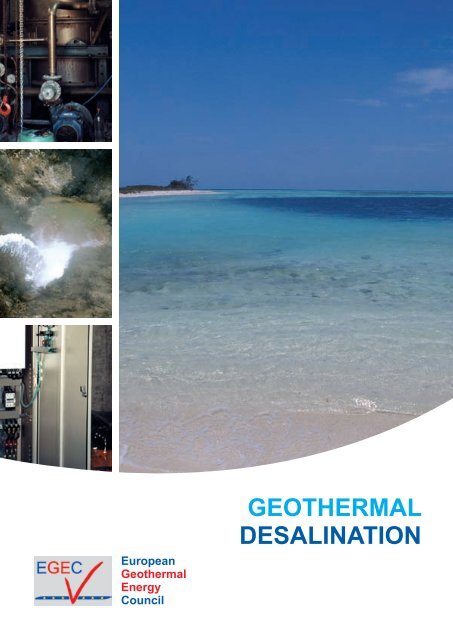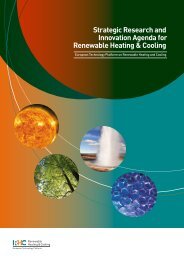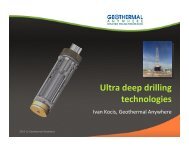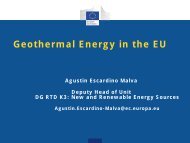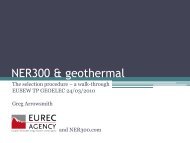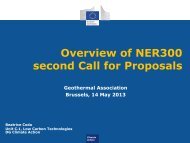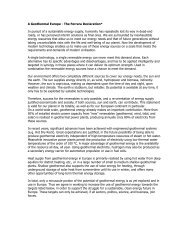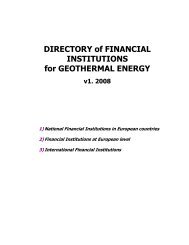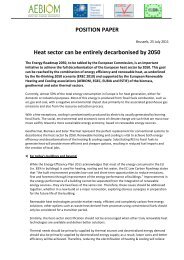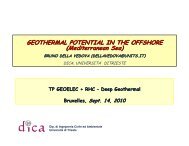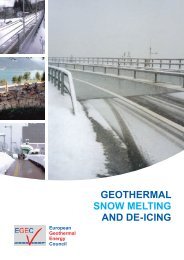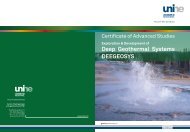GEOTHERMAL DESALINATION - EGEC
GEOTHERMAL DESALINATION - EGEC
GEOTHERMAL DESALINATION - EGEC
Create successful ePaper yourself
Turn your PDF publications into a flip-book with our unique Google optimized e-Paper software.
European<br />
Geothermal<br />
Energy<br />
Council<br />
<strong>GEOTHERMAL</strong><br />
<strong>DESALINATION</strong>
Current Situation<br />
Geothermal Solution<br />
Kimolos:<br />
geothermal wellhead<br />
pump motor.<br />
Kimolos:<br />
seawater pump, filter<br />
and distribution line.<br />
The World Health Organization (WHO)<br />
has estimated that 1000 cubic meters<br />
per person per year is the benchmark<br />
level below which chronic water scarcity is<br />
considered to impede development and harm<br />
human health.<br />
97.5% of the total global stock of water is<br />
saline and only 2.5% is fresh water. Approximately<br />
70% of this global freshwater stock is<br />
locked up in polar icecaps and a major part of<br />
the remaining 30% lies in remote underground<br />
aquifers. In effect, only a miniscule fraction of<br />
freshwater (less than 1% of total freshwater<br />
or 0.007% of the total global water stock) that<br />
is available in rivers, lakes and reservoirs is<br />
readily accessible for direct human use.<br />
Geothermal energy is a source of renewable<br />
energy and the oceans are a major alternative<br />
source of water.<br />
Desalination is very energy-intensive, and<br />
sustainable energy systems urgently need<br />
to be developed. Desalination technology is<br />
providing safe drinking water even to some<br />
‘water-rich’ nations where pollution reduced<br />
the quality of natural waters. Thus, as a<br />
means of augmenting fresh water supplies,<br />
desalination contributes significantly to global<br />
sustainability. Desalination techniques such<br />
as those driven by geothermal heat have<br />
increased the range of water resources available<br />
for use by a community.<br />
Seawater desalination is one of the most<br />
promising fields for the application of geothermal<br />
energy due to the coincidence, in many<br />
places of the world, of water scarcity, seawater<br />
availability and geothermal potential. During the<br />
90s the Kimolos Project was a research project<br />
that successfully demonstrated the technical<br />
feasibility of geothermal seawater desalination<br />
using low enthalpy geothermal energy.<br />
Low enthalpy (t>60°C) geothermal energy<br />
can effectively drive a sea or<br />
brackish water desalination unit in order<br />
to produce fresh water for drinking and/or<br />
irrigation. As a geothermal plant, whether used<br />
for power generation or for space heating or<br />
other applications, has large quantities of<br />
available heat at low cost, the most cost<br />
effective method for seawater desalination is<br />
to provide directly geothermal heat to a MED<br />
(multi effect distillation) plant.<br />
Why should geothermal energy be preferred<br />
in a desalination process ?<br />
1. Geothermal energy provides a stable and<br />
reliable heat supply 24 hours a day, 365<br />
days a year, ensuring the stability of the<br />
thermal processes of desalination.<br />
2. Geothermal production technology, i.e.<br />
to extract hot water from underground<br />
aquifers, is mature.<br />
3. Low temperature MED desalination technology<br />
is also mature.<br />
4. Geothermal desalination yields fresh water<br />
of high quality.<br />
5. MED desalination method has low energy<br />
requirements maximizing the fresh<br />
water output from a given low enthalpy<br />
geothermal potential and minimizing the<br />
corresponding costs.<br />
6. Geothermal desalination is cost effective,<br />
as fresh water costs of less than 1 Euro/<br />
m 3 are possible.<br />
7. Geothermal desalination is friendly to the<br />
environment, as only renewable energy is<br />
used with no emissions of air pollutants<br />
and greenhouse gasses.<br />
8. Geothermal desalination aids local<br />
development and improves employment<br />
perspectives.<br />
9. Geothermal desalination saves foreign<br />
currency as no imported fossil fuels are<br />
used.<br />
10. Geothermal desalination has been successfully<br />
demonstrated on the island of<br />
Kimolos, Greece through a project supported<br />
by the European Commission<br />
(THERMIE GE.438.94.HE).
Multi Stage Distillation - MED<br />
MED powered by geothermal energy<br />
is preferred due to lower energy requirement<br />
in comparison with other<br />
desalination processes. MED method is based<br />
on the multi-effect distillation rising film principle<br />
at low evaporation temperatures (less than<br />
70°C) due to low, almost vacuum, pressure<br />
prevailing in the vessels. The rising effect principle<br />
takes advantage of the fact that the inner<br />
tube surfaces are always covered by a thin film<br />
of feed water that prevents scale formation.<br />
• MED results in excellent water quality with a<br />
salinity level close to 10 ppm.<br />
• Fewer stages (effects) are needed in an<br />
installation compared to an MSF system,<br />
resulting in lower costs per m 3 of produced<br />
fresh water.<br />
• Evaporation through multiple-effect is a very<br />
energy efficient technology, as in each vessel<br />
(effect) the feed water boils utilizing the<br />
heat released by condensing vapor from the<br />
previous effect.<br />
A. Suction ejectors<br />
B. Sea cooling water<br />
inlet condenser<br />
C. Sea cooling water<br />
outlet condenser<br />
D. Freshwater outlet<br />
E. Feed-water inlet<br />
F. Brine outlet<br />
G. Brine heat recovery<br />
H. Heat supply<br />
I. Wet generated<br />
vapour<br />
J. Dry vapour<br />
Case study – Kimolos unit<br />
Apilot unit to demonstrate the feasibility<br />
of exploiting the low enthalpy geothermal<br />
potential of the island for the<br />
production of fresh water through geothermal<br />
water desalination with the objective to achieve<br />
water sufficiency for the island .<br />
• geothermal water flow rate of 60 m 3 /h at a<br />
wellhead temperature of 61-62°C is utilized<br />
from a borehole 188 m deep<br />
• the desalination method used is MED with distillation<br />
under vacuum in vertical tubes and a<br />
two stage desalination unit has been installed<br />
(D-TU-2 -1200 - ALFA LAVAL DESALT)<br />
• the total production of fresh water is approximately<br />
80 m 3 /day<br />
• the produced water cost is estimated of<br />
the order of 1.6 €/m 3 (including only annual<br />
operation costs), which is satisfactory for a<br />
small unit if this size; desalination costs are<br />
expected to be considerably lower in large<br />
scale geothermal desalination plants.<br />
The Kimolos<br />
geothermal<br />
desalination unit.
Advantages<br />
At sites where drinking water is scarce<br />
and geothermal resources with temperatures<br />
of 60-100 °C can be developed<br />
at acceptable costs, it is appropriate to<br />
use geothermal desalination. For reservoirs<br />
with higher temperatures there is also the option<br />
to generate geothermal power for use in a<br />
desalination plant.<br />
Water scarcity is an increasing problem<br />
around the world and everybody agrees<br />
that seawater desalination can help to palliate<br />
this situation. Among the energy sources<br />
suitable to drive desalination processes,<br />
geothermal energy is one of the most promising<br />
options, due to the coupling of the disperse nature<br />
and availability of geothermal energy with<br />
water demand supply requirements in many<br />
world locations.<br />
During the 90s, a Geothermal Desalination<br />
Project carried out in Kimolos island,<br />
Greece, demonstrated the technical feasibility<br />
of geothermal seawater desalination,<br />
through low enthalpy geothermal energy<br />
utilization.<br />
An objective is the development of a least costly<br />
and more energy efficient seawater desalination<br />
technology based on Multi-Effect Distillation<br />
process. Specific proposed technological<br />
developments (new design of absorption heat<br />
pump, hybridization with other energy, cogeneration<br />
and recovering of salt) are expected to<br />
both improve the energy efficiency of the process<br />
and process economy.<br />
The expected result would be an enhanced<br />
MED technology with market possibilities and<br />
suitable to be applied in the Mediterranean<br />
area and similar locations around the world.<br />
• Seawater desalination in itself is an expensive<br />
process, but the inclusion of geothermal<br />
energy sources and the adaptation of<br />
desalination technologies to this renewable<br />
energy supplies can in some cases be a particularly<br />
less expensive and economic way of<br />
providing water.<br />
• The use of geothermal energy for thermal<br />
desalination can be justified in some regions<br />
with the presence of cheap geothermal reservoirs<br />
or in decentralized applications focusing<br />
on small-scale water supply in coastal regions<br />
(e.g. village communities), provided the<br />
ability and willingness to pay for desalination<br />
is sufficiently large.<br />
• What may also prove a feasible option is the<br />
use geothermal power from cheap reservoirs<br />
in coastal areas to desalt seawater in ROplants<br />
(reverse osmosis).<br />
Contact:<br />
<strong>EGEC</strong><br />
European Geothermal Energy Council a.s.b.l.<br />
Renewable energy House<br />
Supported by<br />
63-65 rue d’Arlon<br />
B-1040 Brussels<br />
T : + 322 400 10 24<br />
F : + 322 400 10 10<br />
W : www.egec.org<br />
E : info@egec.org<br />
The sole responsibility for the content of this publication lies with the authors. It does not necessarily reflect the opinion of the European Communities.<br />
The European Commission is not responsible for any use that may be made of the information contained therein.<br />
Photo and graphical elements credits : <strong>EGEC</strong>, CRES, ALFA-LAVAL Published in September 2007 - Text: CRES - Design: ACG Brussels<br />
Printed on ecologically friendly paper (chlorine-free paper)


